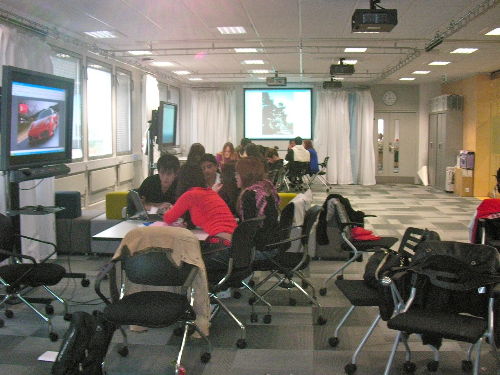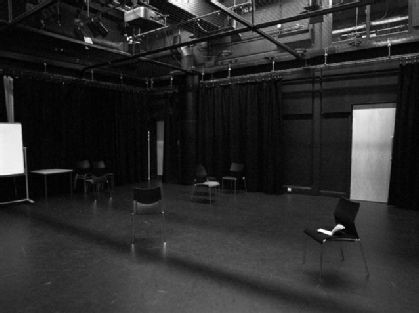3 Spaces Experiment
From October 2009
A brief report on the third session in my Multimedia Communications series for the International Design and Communications MA (in the CAPITAL Studio), with some initial thoughts on two contrasting "user configurable" "open" learning spaces provided by the Teaching Grid and the CAPITAL Centre.
In the previous two sessions we had used the Experimental Teaching Space in the Teaching Grid at Warwick's Library. Here is a photo of us working in that space:

As you can see, we made use of its user-configurable characteristics (movable chairs, tables, "shower curtain" and glass partitions, wifi) as well as plenty of technology (many roof mounted projectors, Smartboards, laptops, cameras etc). I suspect that, despite it's user-configurability, students will always experience it as an office-like space. Some have also said that it doesn't quite feel private enough for them to relax and feel as if they can take creative risks.
For the third session, we used the performance studio belonging to the Creativity and Performance in Teaching and Learning (CAPITAL) Centre - a very different kind of space. Here's a photo:

It's a "black box" studio space, familiar to theatre students and performers. It is described on the CAPITAL web site as:
the CAPITAL Centre's biggest space. As well as hosting workshops and classes, the Studio is also used for performances, masterclasses, training events and visiting practitioners.
And:
a black box studio with semi-sprung harlequin floor. An overhead wired grid provides access to the lighting bars from a technical room on the first floor. There is also the facility to build a section of raked seating in the room. 1
The room was arranged as follows:
- Semi-lit, with a white projector screen at one end;
- A Mobigo portable stand with projector and laptop (MacBook AIR with wifi) in front of the screen;
- A semi-circle of 16 chairs around the Mobigo;
- Three tables, each in a corner, each with a 24" iMac (with wifi).
Due to timetabling limitations, at the start of the session I had to get three students to help me to move the iMacs into the room and set them up. Interestingly, as we did this, the students made themselves at home and started to behave in a playful manner (in fact they found the piano!).
A Description of the Session
I had intended that the session would include three iterations of building prototype designs, collectively testing, and reflecting. However, the testing and reflection elements worked well, and we could only go through two iterations.
I began with the students sitting on chairs in a semi-circle around the projector. The aim of this first part of the 2 hours was to reinforce the "design thinking" approach, with reminders about the design task (building a personal e-portfolio), and the theory of design thinking (iterations, prototyping, 3 spaces). I also wanted to ensure that the students understand that the approach applies equally to processes design, service design, communication design, academic work and the development of more physical products. I wanted to emphasise the importance of the "experience architect" role in this, treating all of these design tasks as being "experience design" processes. To make this clear, I played a video of David Kelley (of the IDEO design company) talk at Stanford about "designing experiences"2.
Kelley is a convincing speaker. I was then able to use a second video of Kelley, in which he talks about his work on prototyping the original computer mouse for Apple. I emphasised the importance in this of understanding the whole user experience3.
However, when compared to the latest Apple mouse (just released), it's clearly a very limited experience! I had hoped to show a video of the new mouse, to illustrate what results a deeper and more wide ranging "experience architecture" can give, but I couldn't get the movie to play over wifi (the only failure of the session).
After these introductory considerations, we moved into the iterative series of activities. I asked the "experience architects" (self-nominated in the first week) from the three teams to form a separate group. Then I gave the remaining team members a task:
In just five minutes, create an engaging, exciting design for an e-portfolio representing a fictional or real IDCM MA student - using words and images.
At the same time, the "experience architects" were to collectively discuss the question:
What kind of experience would satisfy the main audience for the e-portfolio (and who are they)?
The three groups organised themselves around the three iMacs, but in a much more informal and mobile way than they would have done in the Teaching Grid. Many of them ignored the chairs, remaining standing or kneeling down. They seemed to respond well to the task and its five minute limit, being more active than they were when faced with a similar task in the Teaching Grid.
When it came to the time to present their prototype ideas/designs, each group decided quickly upon a mode of presentation. I noticed that they seemed more prepared to take risks and be creative (of course that could have been the result of being three weeks into term, but the step was noticeably large). The panel of "experience architects" got the presenters to focus on them for the presentations, with a definite sense that they were in charge of that part of the session (whereas in the Teaching Grid it always felt as if I were in charge). The feedback was excellent, well thought out and I think most useful. We also reflected on the process a little, with the students responding well to the rapid thinking/creating, prototyping and testing approach.
This first iteration was followed by a second longer iteration of the same task, in which the students developed their ideas further into screen based prototypes.
A Space to Encourage Iterative Creative Risk Taking?
The CAPITAL Studio contrasts dramatically with the Teaching Grid. It is larger, darker, and more private. Perhaps more encouraging of imaginative activities (less like an oppressive office space more like a blank "hollodeck" for active imaginations). It's sense of openness, and it's sprung floor seem to encourage movement. However, I can still configure it to give functionality similar to that in the Teaching Grid. The iMac screens are good enough to replace projector screens for a group of this size (16). Wifi was reliable. And the Mobigo projector and screen worked effectively, with good sound quality. It proved to be a little too dark for my Sanyo Xacti camera when taking wide shots (hence I have no good photos of the session) - I will have to find out about how to control the lighting set up. This is all good for my particular requirements, as:
- I need to encourage the students to search for inspiration amongst each other, and also online;
- The students need to be able to collectively construct "prototype" concepts, theories, explanations, narratives and designs, in some cases using the iMacs (concept maps, Powerpoint, or whatever tools they feel are useful) and in other cases away from the iMacs (so that they construct them fast).
- They need to be able to quickly test their prototypes out on each other, using presentation and performance startegies that may or may not draw upon technology - feeling able to take risks;
- They should be able to give critical feedback to each other openly and in a sensitive manner;
- These processes need to be undertaken iteratively, sometimes quickly, sometimes slowly, but with the teacher guiding the process and drawing them back together to share ideas and reflections.
For the students to successfully address the "design challenge" set as the ultimate goal of this series of workshops, they must become good at the "design thinking" approach as described by Tim Brown:
- Get "inspired" through an active discovery process;
- Through "ideation" (theory building), rapidly create "prototypes", and test them in meaningful contexts (with real people);
- After iterating through "inspiration" and "ideation", move confidently towards "implementation", creating a "shippable" product.
In the Teaching Grid based sessions, we explored this process and tried out some team based "inspiration" and "ideation" approaches. I'm trying to discover how the two spaces (Teaching Grid and CAPITAL Studio) might encourage this kind of behaviour.
I will now follow this up with questionnaires and interviews, so as to discover more about the process and the impact of different learning spaces.
If you are interested in using the CAPITAL Centre's innovative teaching spaces, see http://go.warwick.ac.uk/iatl
Update
In 2010-2011 I based my teaching exclusively in the Reinvention Centre at Warwick. The students were very relaxed and productive (over the full 3 hours). They were happy to try a wide range of OSL activities, and able to rapidly create diagrams and prototypes, displayed on A1 sheets.
______________________________
1CAPITAL Centre web site, http://www2.warwick.ac.uk/fac/cross_fac/capital/roomsandbookings/studio/ [Accessed 26th October 2009]
2Kelley, David, Designing Products vs Designing Experiences, eCorner: Stanford University's Entrepreneurship Corner, March 2001, http://ecorner.stanford.edu/authorMaterialInfo.html?mid=685 [Accessed 26th October 2009]
3Kelley, David, Prototyping the Mouse, eCorner: Stanford University's Entrepreneurship Corner, March 2001, http://ecorner.stanford.edu/authorMaterialInfo.html?mid=687 [Accessed 26th October 2009]
